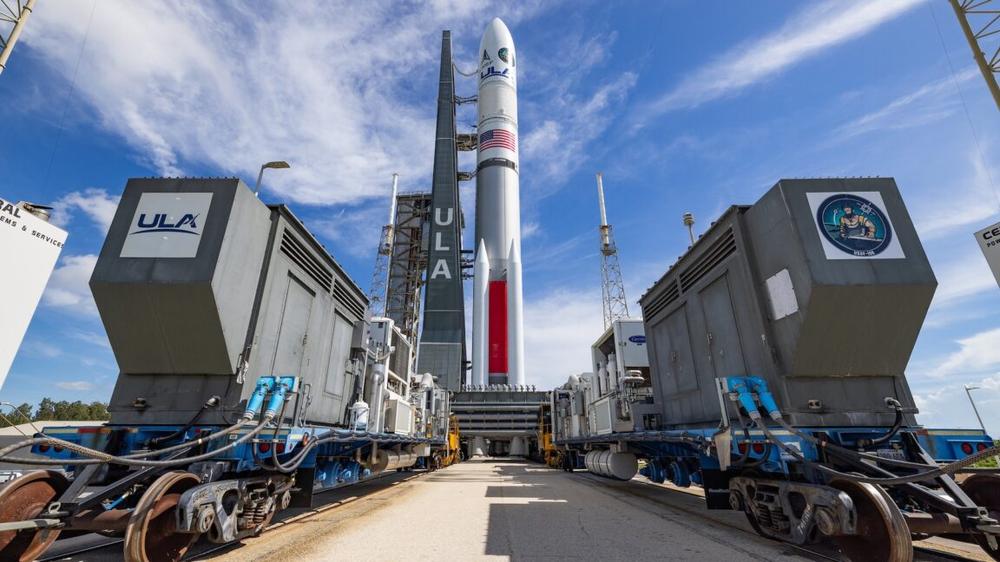After more than a decade of development and testing, US military officials are finally ready to entrust United Launch Alliance's Vulcan rocket to haul a batch of national security satellites into space.
An experimental military navigation satellite, also more than 10 years in the making, will ride ULA's Vulcan rocket into geosynchronous orbit more than 22,000 miles (nearly 36,000 kilometers) over the equator. There are additional payloads buttoned up inside the Vulcan rocket's nose cone, but officials from the US Space Force are mum on the details.
The Vulcan rocket is set for liftoff from Cape Canaveral Space Force Station, Florida, at 7:59 pm EDT (23:59 UTC) Tuesday. There's an 80 percent chance of favorable weather during the one-hour launch window. It will take several hours for the Vulcan rocket's Centaur upper stage to reach its destination in geosynchronous orbit. You can watch ULA's live launch webcast below.
The Vulcan rocket flew two demonstration missions in 2024, capping a lengthy campaign to design, build, and test ULA's new launch vehicle before the Space Force could declare it ready for operational service.
Now, ULA is poised to begin ticking off a backlog of more than 70 Vulcan launches the company has sold to commercial and government customers. The new rocket's largest users, by far, will be Amazon and the US Space Force.
New and improved
"We're excited to see this mission launch," said Gary Wentz, ULA's vice president of government and commercial programs. "This will be the most powerful Vulcan yet."
The first two Vulcan test flights last year used a configuration of the rocket with two strap-on boosters to add an extra burst of speed off the launch pad. For this flight, which the Space Force has named USSF-106, the launcher will fly with four solid rocket boosters made by Northrop Grumman.
These boosters are larger versions of the solid rocket motors ULA and its predecessors have flown on their previous rockets for 35 years. Despite their long history of successful flights, the boosters came under the microscope after a nozzle failure on the second Vulcan test flight last October. The nozzle at the bottom of one of the solid rocket boosters fell off the launcher moments after liftoff, but the motor continued firing, and Vulcan still made it to its intended orbit.
The setback contributed to the delay of the Space Force's first operational flight with the Vulcan rocket from the end of last year until now. Engineers determined that a carbon composite insulator, or heat shield, inside the nozzle failed to protect the nozzle's metallic structure from the super-heated exhaust coming from the booster. Investigators traced the cause of the failure to a "manufacturing defect" in one of the insulators, which led to the melting and burn-through of the booster nozzle.
The rest of the Vulcan rocket performed close to perfection on the two test flights last year, including the vehicle's BE-4 main engines supplied by Blue Origin, the space company owned by billionaire Jeff Bezos. Two BE-4s fly on each Vulcan rocket, consuming cryogenic methane and liquid oxygen for the first five minutes of flight.
Space Force officials formally certified the Vulcan rocket for national security launches in March, setting the stage for Tuesday's launch of the USSF-106 mission.
United Launch Alliance, a 50-50 joint venture between Boeing and Lockheed Martin, is one of two companies approved to launch the Pentagon's most expensive and sensitive satellites. SpaceX is the other one, and that company's Falcon 9 and Falcon Heavy rockets have overtaken ULA's launch vehicles, thanks largely to booster reuse. Vulcan, like ULA's legacy Atlas and Delta rockets, is currently designed for a single use. Eventually, ULA aims to recover and reuse the BE-4 engines themselves, but not the entire Vulcan core stage.
Despite its higher cost and unproven capability, the Vulcan rocket won the lion's share of US military launch contracts from 2020 through 2024, while SpaceX received a bit less than half of the launch orders the Pentagon put up for competition between the two providers. The balance shifted with a new round of launch contracts awarded in April, with SpaceX becoming the military's leading launch provider and ULA taking second place. Blue Origin also won the right to receive a handful of military launch contracts with its New Glenn rocket, which debuted in January.
The Vulcan rocket checks off several important boxes for the Space Force. First, it relies entirely on US-made rocket engines. The Atlas V rocket it is replacing uses Russian-built main engines, and given the chilled relations between the two powers, US officials have long desired to stop using Russian engines to power the Pentagon's satellites into orbit. Second, ULA says the Vulcan rocket will eventually provide a heavy-lift launch capability at lower cost than the company's now-retired Delta IV Heavy rocket.
Third, Vulcan gives the Space Force another option besides SpaceX's Falcon 9 and Falcon Heavy, which have been the only rockets in their class available to the military since the last national security mission launched on an Atlas V rocket one year ago.
Col. Jim Horne, mission director for the USSF-106 launch, said this flight marks a "pretty historic point in our program's history. We officially end our reliance on Russian-made main engines with this launch, and we continue to maintain our assured access to space with at least two independent rocket service companies that we can leverage to get our capabilities on orbit."
What’s onboard?
The Space Force has only acknowledged one of the satellites aboard the USSF-106 mission, but there are more payloads cocooned inside the Vulcan rocket's fairing.
The $250 million mission that officials are willing to talk about is named Navigation Technology Satellite-3, or NTS-3. This experimental spacecraft will test new satellite navigation technologies that may eventually find their way on next-generation GPS satellites. A key focus for engineers who designed and will operate the NTS-3 satellite is to look at ways of overcoming GPS jamming and spoofing, which can degrade satellite navigation signals used by military forces, commercial airliners, and civilian drivers.
"We're going to be doing, we anticipate, over 100 different experiments," said Joanna Hinks, senior research aerospace engineer at the Air Force Research Laboratory's space vehicles directorate, which manages the NTS-3 mission. "Some of the major areas we’re looking at—we have an electronically steerable phased array antenna so that we can deliver higher power to get through interference to the location that it's needed."
GPS jamming is especially a problem in and near war zones. Investigators probing the crash of Azerbaijan Airlines Flight 8243 last December determined GPS jamming, likely by Russian military forces attempting to counter a Ukrainian drone strike, interfered with the aircraft's navigation as it approached its destination in the Russian republic of Chechnya. Azerbaijani government officials blamed a Russian surface-to-air missile for damaging the aircraft, ultimately leading to a crash in nearby Kazakhstan that killed 38 people.
"We have a number of different advanced signals that we’ve designed," Hinks said. "One of those is the Chimera anti-spoofing signal... to protect civil users from spoofing that’s affecting so many aircraft worldwide today, as well as ships."
The NTS-3 spacecraft, developed by L3Harris and Northrop Grumman, only takes up a fraction of the Vulcan rocket's capacity. The satellite weighs less than 3,000 pounds (about 1,250 kilograms), about a quarter of what this version of the Vulcan rocket can deliver to geosynchronous orbit.
Horne demurred when asked about what else the Vulcan rocket will deploy in orbit: "I’ll just say that any other further details beyond NTS-3 are not releasable to the public, and leave it at that... We’re not going to make any further comments on anything beyond NTS-3 in the mission stack."
The Space Force's refusal to disclose any information about additional payloads on the USSF-106 mission, even a total number of satellites aboard Vulcan, is somewhat of an outlier compared to the way military officials have historically handled these questions. While the Space Force has consistently kept secret details about specific maneuvers and instruments (or in some cases, potential weapons), officials have named and numbered the payloads carried aboard nearly all recent national security launches.
This is in contrast to the National Reconnaissance Office, which owns the US government's fleet of spy satellites. The NRO has nearly always followed a stricter protocol of secrecy than the Air Force or Space Force.
That changed last year, when a classified Space Force mission named USSF-51 launched on an Atlas V rocket. Military leaders didn't disclose the mission's purpose or how many satellites it was carrying until the Space Force officially catalogued three payloads from the launch in its publicly accessible list of all human-made objects in orbit.
Some of the Space Force's most secret satellites have the ability to release smaller spacecraft themselves, adding to the uncertainty for potential adversaries. Some information about the payloads on Tuesday's launch might become public as the Space Force adds them to the public catalog, and a network of amateur skywatchers on Earth stand ready to observe their movements thousands of miles overhead.

 Adorama Is Clearing Out This Apple MacBook Pro M3 Pro Laptop by Offering a $700 Off Discount
Adorama Is Clearing Out This Apple MacBook Pro M3 Pro Laptop by Offering a $700 Off Discount